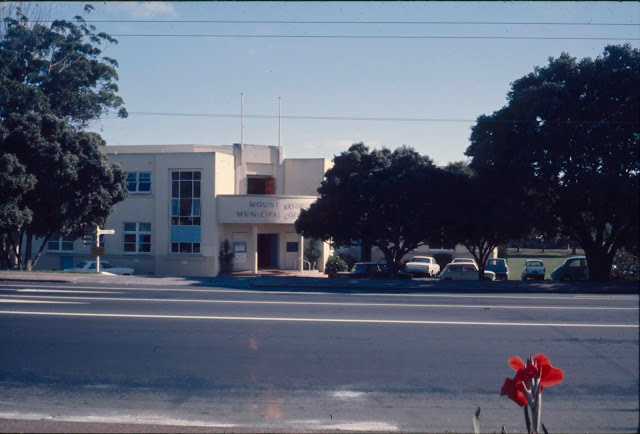In the days prior to the Auckland City amalgamation of 1989, the Borough Council building held a significant place in the community. One went in to pay the rates, pick up rat bait (issued free upon request), and maybe even caught a glimpse of the mayoral robes. This month, one of those buildings returns to new life after a controversial few years. The Mt Roskill Borough Council Municipal Building at Three Kings – the Metrowater building to locals – is back in use after the discovery of toxic black mould saw it in limbo. With rumours of a push to demolish, the local historical society petitioned for it to be saved and now, renovated in all its pink-peach glory, it is once again the home of the Local Board.
 |
| Image: Mount Roskill Borough Council Chambers viewed from Mount Albert Road, 1975. Auckland Council Archives, MRB 009/633. |
Built in 1956, the complex was considered by then MP John Rae, a ‘dream home’ for the council. He had called the previous Roads Board offices down the road a ramshackle collection of corrugated iron sheds. They had been in use since 1903.
 |
| Image: Payout - unemployed relief workers outside Mount Roskill Road Board office, 1931. Auckland Council Archives, MRB 027/1g. |
A new municipal centre had been on the drawing board as far back as the 1920s with plans to build on the corner of Mt Albert and Three Kings Roads. It was a decade before a proposal was prepared, and it was ambitious. There would be not only a municipal building, but a 600-seat hall, shops and later, a cinema. However, the loan application was declined.
In 1937 two options came before the Roads Board: either add on to the existing offices, or construct a new building on the site at Three Kings. Again, the proposal fell through. Two years on, a new building was back on the table. A design was chosen, but with the advent of the Second World War, the project was abandoned. The photo below shows where Three Kings Road meets Mt Albert Road, and the designated site opposite Three Kings School.
In 1945 architects Gummer and Ford were selected to design something new. Their plan included shops, a Post Office and a bank branch. There would be a hall to accommodate 450 people complete with an orchestral pit, large stage, a dance floor for 250 couples, clubrooms and showers. The plan allowed for the municipal offices to be upstairs with a caretaker’s flat at roof level. Plunket rooms would be set in the gardens and would include an extensive veranda where perambulators could be parked. The estimated cost was 50,000 pounds. Application was made to the Local Government Loans Board, and it was referred back to the ratepayers for approval. It was rejected due to the expense. Two years later another scheme was proposed and yet again, fell through.
Finally, in 1954, the Borough Council proceeded with the plan that resulted in the current building.
 |
| Image: Mount Roskill Municipal Chambers, 1965. Auckland Council Archives, MRB 027/2aj. |
Designed by local architect, Stephen George Wright, it is now considered an example of the development of Modern architecture in this country. The “ramshackle collection of corrugated iron sheds” 300 yards down the road were subsequently designated as community rooms, and demolished in the 1970s. The new building opened in 1957, with Mt Roskill Borough mayor Keith Hay presiding, and for the next 30-odd years was the municipal home of the borough. That community ideal was in its prime at Christmas, with lights decorating the pine in the carpark, and Carols by Candlelight held on the reserve below.
 |
| Image: Carols by candlelight, no date. Auckland Council Archives, MRB 111/1-6-3 box 19 |
At the 1989 amalgamation, the building became the headquarters of Metrowater. At the 2010 amalgamation, the Puketapapa Local Board and other council entities were housed there - until the discovery of the toxic mould in the circa-1990 additions. Now headquarters once again to the Local Board, it’s an inspiring tale of how a local community can fight to retain a significant, local landmark, and succeed in preserving local heritage.
Author: Joanne Graves, Research Central
With thanks to Lisa Truttman and John Adam for their research assistance.





Comments
Post a Comment
Kia ora! Please leave your comment below.